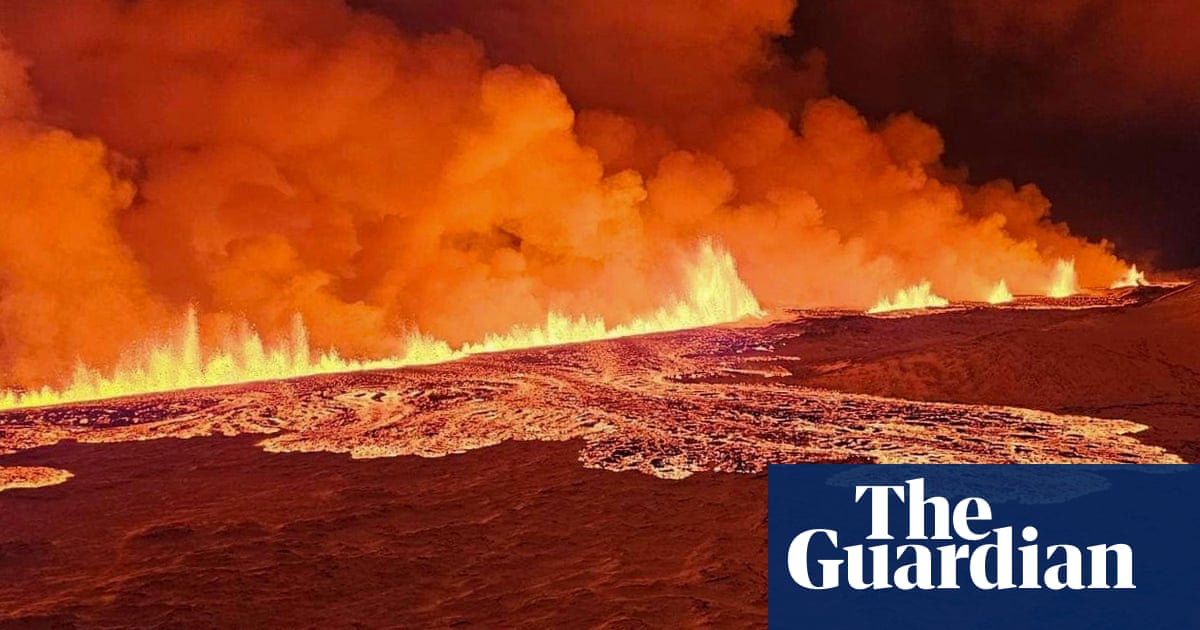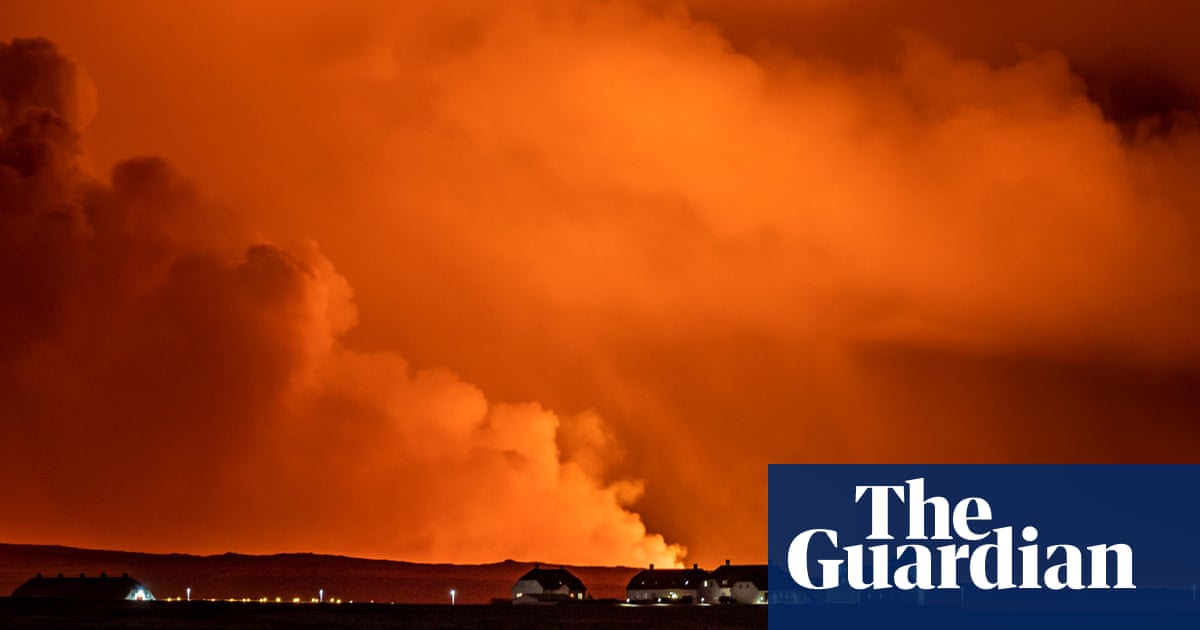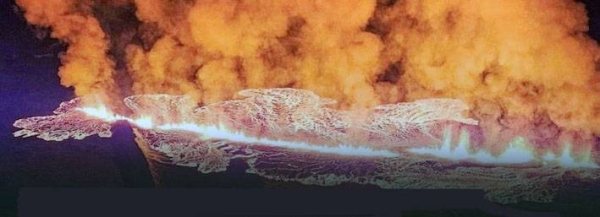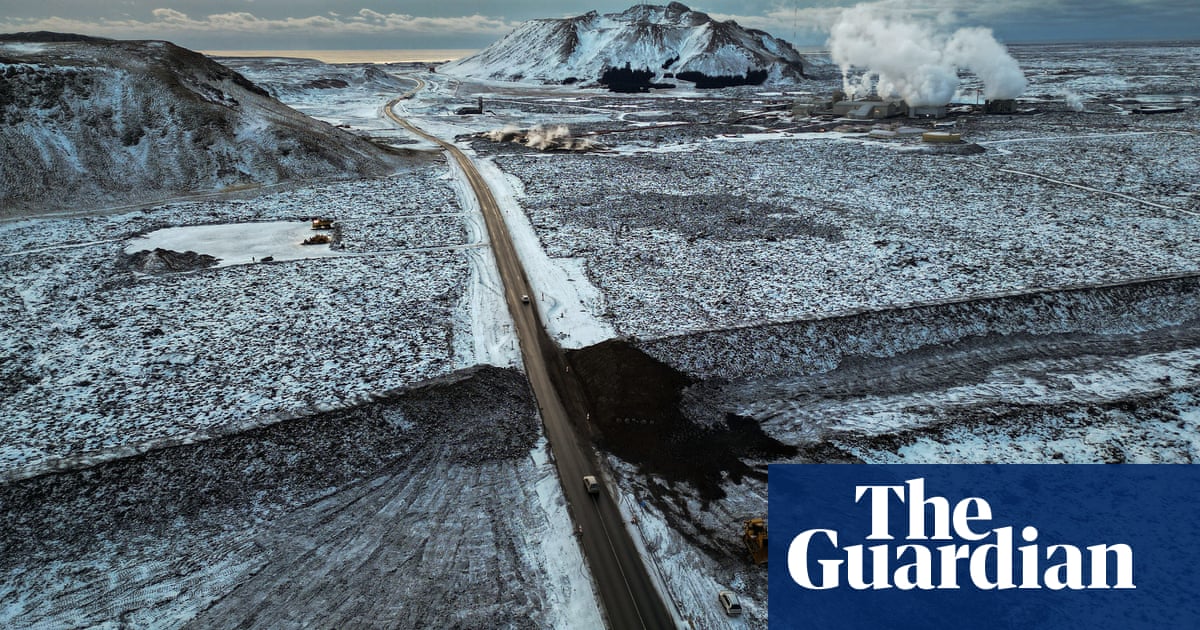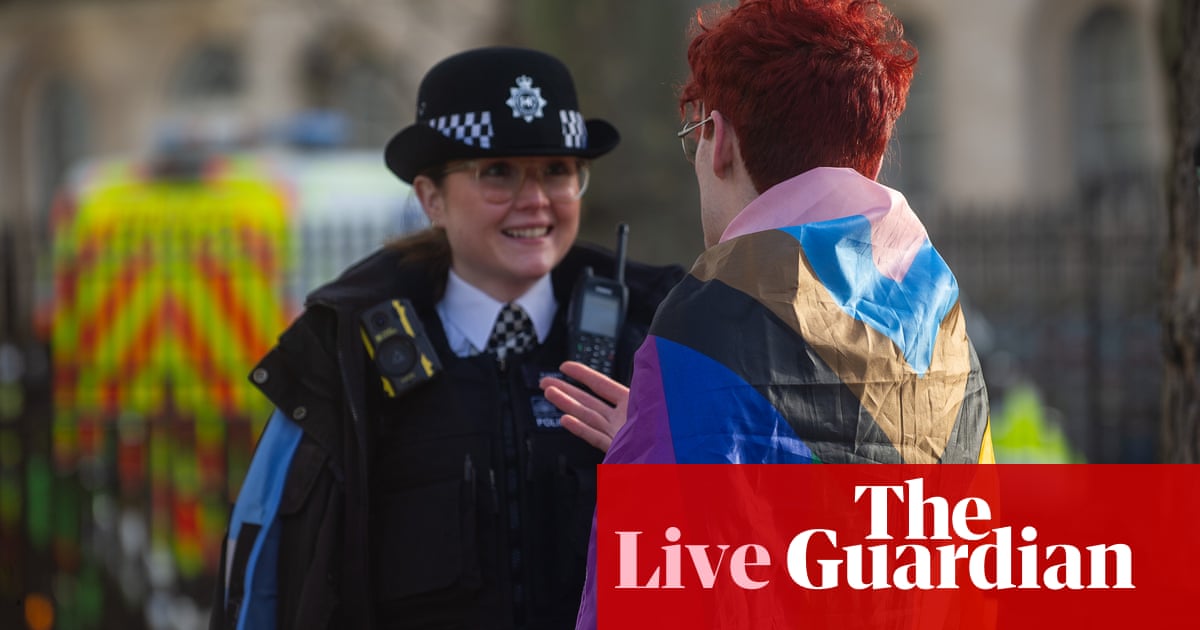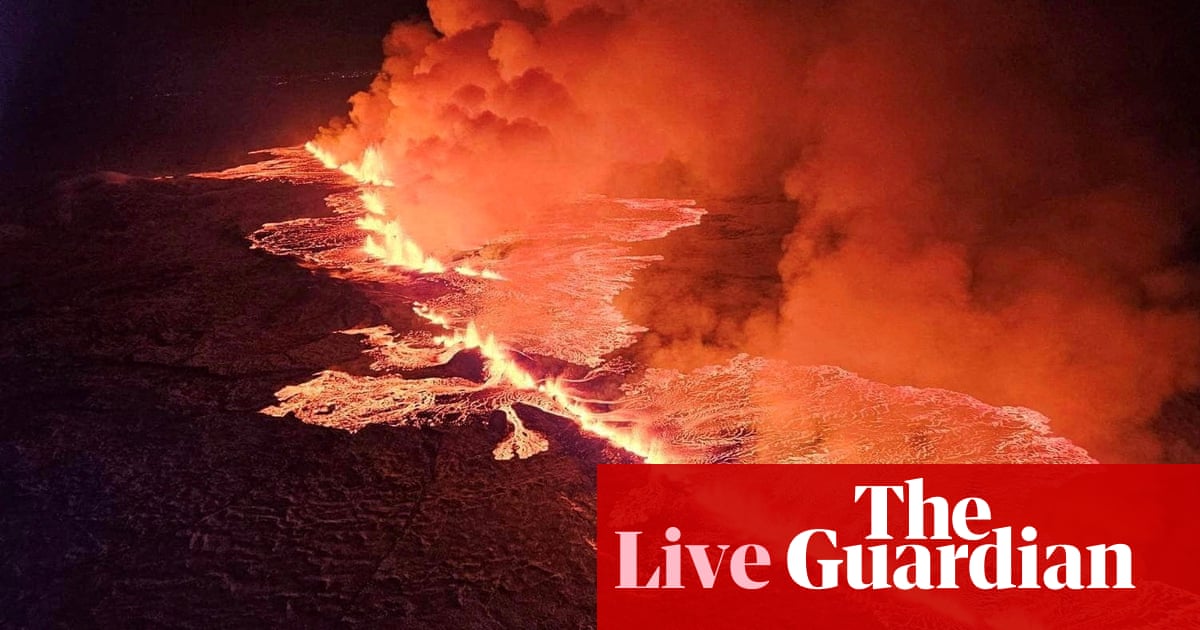
Eruption "does not present a threat to life", government says
The Icelandic government has said the volcanic eruption “does not present a threat to life”, as experts suggested that Grindavík could be spared as the lava appears to be flowing away from the town.
“The eruption does not present a threat to life,” the government said in a statement.
It added:
There are no disruptions to flights to and from Iceland and international flight corridors remain open.
The southernmost point of the 4km (2.5 mile) fissure remains 3km away from Grindavík, the met office said.
“The eruption is taking place north of the watershed, so lava does not flow towards Grindavík,” the geologist Bjorn Oddson told public broadcaster RUV.
Summary of the day
A volcano on the Reykjanes peninsula in south-west Iceland has erupted after weeks of intense earthquake activity.
The eruption began at about 10.17pm local time on Monday, after a series of small earthquakes at about 9pm, the Icelandic met office said.
After the eruption, the Icelandic prime minister, Katrín Jakobsdóttir, said: “Now we see the earth opening up”.
Guðni Th Jóhannesson, the president of Iceland, said: “We now wait to see what the forces of nature have in store.”
The Icelandic government said the volcanic eruption “does not present a threat to life”.
In an overnight update, the Icelandic Met Office said “the eruptive fissure is about 4km long” and that the “distance from the southern end to the edge of Grindavík is almost 3km”.
Grindavík residents, all 3,800 of whom were evacuated from their homes on 10 November, were only yesterday told by police that they may be permitted to return to their homes full-time by Christmas.
By late morning, lava from the eruption appeared to be flowing away from the town, offering hope that homes that have survived the weeks of earthquakes in Grindavík might be spared.
Sigurður Ingi Jóhannsson, Iceland’s minister of infrastructure, said “we seem to have been quite lucky with the location and development” of the eruption.
Matthew Watson, professor of volcanoes and climate at the University of Bristol, said that “it is unlikely, but not impossible that there may be some impact on air travel”.
Summary
The Icelandic met office initially said the magma was moving to the south-west and that the eruption might continue in the direction of Grindavík. Then, the crack in the Earth’s surface was about 2.1 miles long and had grown rapidly.
Between 100 and 200 cubic metres (3,530 and 7,060 cubic ft) of lava was emerging per second, several times more than in previous eruptions in the area.
But by late morning, lava from the eruption appeared to be flowing away from the town, offering hope that homes that have survived the weeks of earthquakes in Grindavík might be spared.
The southernmost point of the fissure – which had since grown to 4km (2.5 miles) long – was still 3km away from Grindavík, the met office said.
“The eruption is taking place north of the watershed, so lava does not flow towards Grindavík,” the geologist Bjorn Oddson told the public broadcaster RUV.
Local police said they had raised their alert level as a result of the eruption and the country’s civil defence advised the public not to approach the area while emergency personnel assessed the situation.
A journalist and photographer from Iceland’s mbl.is flew in a helicopter close to the eruption site.
Here are more images from Iceland
Q&A: What we know about Iceland"s volcanic eruption
What has happened and why?
At 22:17 local time on Monday, a volcanic eruption began north of Grindavík on the Reykjanes peninsula in Iceland.
The eruption came after weeks of intense earthquake activity and uncertainty about what would happen next.
Grindavík, a fishing town with a population of 3,800 located about 25 miles (40km) south-west of Iceland’s capital, was evacuated in November due to safety concerns.
In an overnight update, the Icelandic Met Office said “the eruptive fissure is about 4 km long” and that the “distance from the southern end to the edge of Grindavík is almost 3km.”
Are people in danger?
Iceland’s government said in a statement today that the volcanic eruption “does not present a threat to life”, as experts suggested that Grindavík could be spared as the lava appears to be flowing away from the town.
Sigurður Ingi Jóhannsson, the country’s minister of infrastructure, told broadcaster RÚV that “we seem to have been quite lucky with the location and development [of the eruption], and we hope that will continue”.
Nevertheless, residents of Grindavík appear to have had an incredibly narrow escape: only yesterday, police suggested there could be a possibility that residents might be permitted to return home without restrictions for Christmas.
Is this going to spark another global flight crisis?
The Icelandic government said “there are no disruptions to flights to and from Iceland and international flight corridors remain open.”
Experts say the volcanic eruption is unlikely to impact air travel.
“There is currently no threat to the airspace from this eruption, especially to flights further than Iceland,” said Sam Mitchell, a research associate in volcanology at the University of Bristol.
“Any changes to air traffic to air traffic may be restrained to Keflavik if there are changes in wind direction or outputs of gas and fine ash,” he said, noting that “this is a very different eruption to that of Eyjafjallajokull in 2010 where a large explosive eruption under a glacier produced a very large cloud and very fine ash in the atmosphere when the wind direction was pointing towards mainland Europe”.
How long could this last & what will happen to Grindavík evacuees?
It remains unclear whether the eruptions will continue, and when locals can return home.
“It is very difficult to say how long these eruptions will last; it could be days, it could be months,” said the University of Bristol’s Mitchell.
“Larger more intense eruptions tend to last a shorter time, but if the flow rate becomes small it could go on for some time,” he added.
Officials are taking a wait-and-see approach.
Iceland’s president, Guðni Th. Jóhannesson, said “we now wait to see what the forces of nature have in store”.
“We are prepared,” he said, “and remain vigilant.”
Iceland "quite lucky," minister says
The Icelandic government says the country has so far “been quite lucky” with the location and development of the eruption, adding: “We hope that will continue.”
Sigurður Ingi Jóhannsson, Iceland’s minister of infrastructure, told broadcaster RÚV:
“I think it’s very difficult to say anything when nature is involved, but as it seems to be drawing up this morning, we seem to have been quite lucky with the location and development [of the eruption], and we hope that will continue.”
Eruption "does not present a threat to life", government says
The Icelandic government has said the volcanic eruption “does not present a threat to life”, as experts suggested that Grindavík could be spared as the lava appears to be flowing away from the town.
“The eruption does not present a threat to life,” the government said in a statement.
It added:
There are no disruptions to flights to and from Iceland and international flight corridors remain open.
The southernmost point of the 4km (2.5 mile) fissure remains 3km away from Grindavík, the met office said.
“The eruption is taking place north of the watershed, so lava does not flow towards Grindavík,” the geologist Bjorn Oddson told public broadcaster RUV.
Matthew Watson, professor of volcanoes and climate at the University of Bristol, said: “It is unlikely, but not impossible that there may be some impact on air travel, although this type of eruption doesn’t generally produce much ash which is what tends to ground planes.”
He added:
The eruption looks to be larger than those recently seen in south-west Iceland and the Icelandic Met Office are monitoring the eruption.
This style of eruption is amongst the most spectacular ever seen and there will be a strong pull for tourists, even though the Blue Lagoon complex has again shut.
Tourists should strictly follow official advice as there are significant hazards, such as new breakouts, which can quickly put people in harm’s way.
Narrow escape for Grindavík residents
Residents of Grindavík appear to have had an incredibly narrow escape, with last night’s eruption taking everyone – from residents to authorities – by surprise.
Only yesterday, police suggested there could be a possibility that residents of the fishing town might be permitted to return home without time restrictions for Christmas and the nearby geothermal spa the Blue Lagoon, a hugely popular tourist attraction, which reopened on Sunday.
Fortunately, last night when the volcano erupted, nobody is thought to have been living in the town.
Sólný Pálsdóttir, whose Grindavík home was already on a 50cm slant as a result of the earthquakes before the eruption struck, said: “Nobody was expecting this [eruption] last night. It surprised all of the scientists.”
Her family home is the closest home to the eruption, currently 3km away, meaning it is practically “in my backyard”.
“It came up really quickly and no one was prepared,” she told the Guardian. “The police was saying [on Monday] maybe we could go home tomorrow [Wednesday].”
Last night, after getting a notification of a big earthquake on an app as she was about to go to sleep, she watched the red of the eruption helplessly from the window of her family’s temporary accommodation in Reykjavík. “It was strange to stand here,” she said. “It had so much power when it started that people could see it from many places.”
The Icelandic Met Office has said it is due to have a meeting with civil defence at 9.30am local time.
Aerial footage shows Iceland volcano spewing lava
Footage filmed from an Icelandic coastguard helicopter showed the orange lava set against the dark of the night sky.
Lovísa Mjöll Guðmundsdóttir, a specialist in natural hazards at the Icelandic Met Office, told mbl.is that the southernmost part of the corridor dying out. “The strongest activity is in the middle of the fissure,” she said.
She added:
The activity of the eruption has been greatly reduced since the beginning and the average lava flow is 250 cubic meters per second. But there is great uncertainty in the measurements regarding the lava flow and this is only a first estimate.




